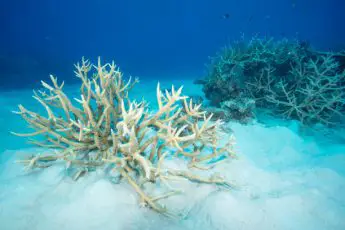Introduction
Quick Navigation
The environment is a significant component of the biosphere where living organisms breed. Ideally, there are two types – Terrestrial and Aquatic. As much as work is done to keep the terrestrial environment safe and habitable, the same should go for marine. There is no point in taking care of land if little or no effort is contributed towards the marine habitat.
One of the significant problems the marine environment faces is Coral Bleaching, which is caused by different reasons, such as rising seawater temperatures and pollution. From observation, it was discovered that sunscreens were major pollutants of the oceans, and that has caused so much harm underwater – including to lives.
This article will help you learn more about coral bleaching and prevent it so that the marine environment is safe.
What is Coral Reef Bleaching?
The change in color of coral reefs from vibrant to pale is called Coral Reef Bleaching. This situation with reefs happens due to the lack of zooxanthellae, which is a type of algae and food source for Corals.
Zooxanthellae and Corals maintain a symbiotic relationship by creating a micro-ecosystem. If these Corals lack this food source, they lose color vibrance and become a piece of vulnerable skeleton. At this point, they are unable to reproduce and are susceptible to diseases and damage.
What Causes Coral Reef Bleaching Underwater?
The instability or non-existence of the symbiotic relationship causes reef bleaching; however, some factors play a role.
Heat or Rising Temperatures
There is a particular temperature suitable for life underwater – especially the corals. When the temperature gets higher, i.e., exceeds normal, life underwater is affected adversely. In this case, rising ocean temperatures and exposure of shallow waters to sunlight can affect life, including coral reefs. Zooxanthellae may not find the high temperature comfortable and settle on corals somewhere more convenient. The exposed corals, however, receive direct impact of sunlight or heat and begin to turn pale.
Pollutants
Land-based pollutants such as debris, sunscreens, etc., are other factors responsible for coral bleaching. They reduce water quality, making it almost inhabitable for marine animals.
Debris, for instance, limits the availability of nutrients and oxygen needed for coral reefs and zooxanthellae to survive. On the other hand, non-biodegradable sunscreens release toxic chemicals such as Titanium Zinc Oxide and Oxybenzone that aren’t right for the health of these organisms – causing death at extremes. Hence, Zooxanthellae have no choice but to migrate to other areas.
How to Prevent Coral Reef Bleaching?
Now that you know what causes the bleaching and how it adversely affects the environment take the below steps as prevention.
Biodegradable Sunscreens
One of the best ways to prevent coral reef bleaching is by investing in biodegradable sunscreens. It is quite unfortunate that sunscreens always find their way into the oceans of the world. They have negatively affected marine life, causing deaths of different species of animals.
However, biodegradable Sunscreens are perfect replacements for the non-biodegradable ones because they help protect the marine ecosystem. This sunscreen type contains ingredients that are eco-friendly and can break down naturally in water. As long as they are reef-friendly, bleaching is impossible.
Check out some of the best biodegradable skincare brands on the market that guarantee safety, and choose your most preferred.
See here for more on Biodegradable Sunscreens.
Proper Waste Management
Also, proper waste management is another way to prevent bleaching in the control of pollutants that destroy coral reefs.
Many people are fond of littering the oceans of the world with dirt, debris, and toxic waste from industries. The impact of this behavior is devastating because marine life is affected. However, with proper waste disposal and control of ocean plastics, the environment becomes safe and habitable for life, including coral reefs.
Likewise, people should start investing in recycling, and reusing, instead of disposing of in oceans. If this task is taken up wholeheartedly, there is a good chance that ocean health will be quite great once again.
Avoid Touching Coral
Another thing that will prevent coral reef bleaching in water is to avoid touching them. On several occasions, divers and swimmers have interfered and disturbed the relationship between corals and Zooxanthellae – accidentally or intentionally. When this happens, there is a disturbance, almost making the Zooxanthellae feel threatened and move to another location. That migration leaves corals vulnerable to damage or destruction.
Besides, Corals are delicate animals that are quite sensitive to touch. Therefore, you mustn’t touch or scrape them. Furthermore, you should avoid swimming in shallow waters because you will likely encounter them with your body positioning sooner than you realize.
Environment and Conservation Programs
It is everyone’s responsibility to take of the environments – terrestrial and marine. Coral reef bleaching doesn’t stand a chance when everyone is working together to ensure that ocean health is protected and preserved in the best ways possible. Organizing or joining environment and conservation programs is an ideal way to start. Here, you get to lecture people about the dangers of coral reef bleaching and how it ultimately affects the entire ecosystem. Having people believe ocean care and maintenance is a corporate social responsibility is vital.
Why Do You Need to Pay More Attention to this Condition?
Coral reefs are important to our world because most marine life depends on them for food and growth – hence, they are essential for maintaining a stable ecosystem. It is pertinent to pay attention to this condition so that there won’t be long-lasting damage to the whole ecosystems. Besides, there is a direct relationship between both environments that need to be maintained properly.
Conclusion
Coral Reef Bleaching is a crucial concept that needed to be explored because the entire fate of the marine ecosystem depends on it. While it was important to identify the causes, i.e., pollutants and rising temperatures, prevention tips were also needed. Overall, if you take care of the world you live in, nothing can stop you from having healthy breathing space.

